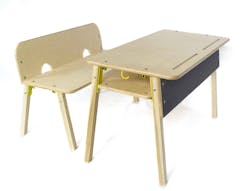Providing a comfortable environment with reliable furniture and supplies is an essential part of any student’s learning. That is why UNICEF, the United Nations agency aimed at improving the lives of children and their families in low- and middle-income countries, launched an international tender to design ergonomically correct, child-friendly, and sustainable classroom furniture for children globally, particularly in Sub-Saharan African communities—where consistency, quality, and new design could be challenging.
Based on a competitive process, UNICEF selected Mary Burnham and Jeff Murphy, partners at Murphy Burnham & Buttrick Architects in New York as the architect firm that would design the classroom furniture. The team created prototypes of two new desks and a chair that fully meet with UNICEF requirements, and that could also be made by the region’s small-scale, local manufactures. The designs were developed on an open-source platform and made available to all.
Designing Classroom Furniture that Matters
“We were attracted to UNICEF’s humanistic agenda and their commitment to education and serving children,” said Murphy of his inspiration for getting involved. Burnham and Murphy started by surveying school furniture use and common fabrication methods in Rwanda and Malawi. They then presented their research and design approaches to UNICEF’s Innovation Unit in Copenhagen, where a team of external experts provided feedback and helped them decide on the final three designs.
Made with wood, painted metal tubes, and simple joinery, the new UNICEF furniture designs were tested in Copenhagen and by field researchers (Malawi students). After final tests and a few minor changes, prototypes of the desks and chairs were sent eventually to Malawi, where they serve as model pieces to be copied by local fabricators. Since the project’s initial start in 2012, a total of 4,186 sets of furniture have been or are in the process of being installed across Rwanda, Malawi, and Ethiopia in 10 schools and 32 classrooms.
How to get involved
UNICEF creates Target Product Profiles (TPPs) to communicate requirements for products which are currently not available on the market, but which fulfill a priority need to be used in the unique context in which UNICEF and its partners operate. TPPs include information on how the new product will be used, by or for whom, and the minimum and ideal performance criteria. The purpose of TPPs is to guide industry to develop products that meet UNICEF’s needs, however, they do not act as the final procurement specifications, but rather as a list of desired requirements that combined describes the ideal product considering the context. Learn more about TPPs and sign up to receive updates by clicking here.
We Love Design. You Love Design. Here's Even More.
About the Author

Adrian Schley
Associate Editor
Adrian Schley was an Associate Editor for i+s, where she covered the commercial interior design industry since 2018. Her work can also be found in BUILDINGS and Meetings Today.
